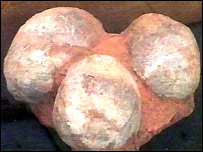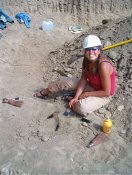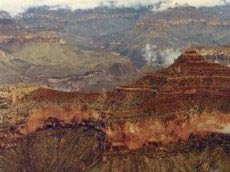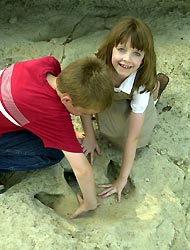| (insert your NIE or newspaper logo here) |
Weekly Online LessonOnline Lesson ArchiveGrade Level: 3-5
|
Digging into the Past
 On
February 23, 2006, federal agents announced that they
had seized about seven tons of stolen "jewels" in Tucson,
Arizona. The recovered goods are worth thousands of dollars
and took millions of years to make.
On
February 23, 2006, federal agents announced that they
had seized about seven tons of stolen "jewels" in Tucson,
Arizona. The recovered goods are worth thousands of dollars
and took millions of years to make.
But these aren't your typical glittery gems. They are rare fossils—traces of organisms from a past geologic era like the Jurassic Age.
The stolen fossils included three football-sized dinosaur eggs. Thieves were trying to sell them at a gem and fossil show for $1,400 a piece. But scientists estimate the value at $4,000.
So what makes fossils so valuable to scientists? Fossils provide information about the Earth's history. They shed light on what kinds of animals and plants lived over the years, when they lived, and under what environmental conditions.
During this week's lesson, you'll discover how fossils are found and how they help scientists reconstruct the past.
Digging for Dinosaur

Start your journey with a hands-on Dino Dig Interactive Game at the National Museum of Natural History.
Click the underlined link to launch the game. You should see arrows with a combination of numbers in the bottom right corner. If you do not see them, try using a different Web browser.
Read the introduction to the interactive game. How long ago did the dinosaurs live? What is today's environment like? What plants and animals live there now?
Go to the next screen using the forward arrow. Read the instructions, and then start the dig using your rock pick to take off the top layers of rock. Make sure to get every highlighted piece.
For the next step, use the rock hammer and chisel to break out chunks from around the fossil. Then use the paintbrush to dust it off. Why do you think it's important to use different tools for different types of jobs?
 What
kinds of events may have happened to encase that
animal in rock? What may have caused the rock to erode
around the fossil, so that it could be seen on the
surface?
What
kinds of events may have happened to encase that
animal in rock? What may have caused the rock to erode
around the fossil, so that it could be seen on the
surface?
Now it's time to take the fossil out of its rock bed, plaster it with toilet paper and burlap, label it, and then drive the fossil to the natural history museum.
Once there, open up the plaster jacket, prepare the specimen, and assemble the skeleton for display. When you click on a bone piece, read the description to help you put it together.
What clues from fossilized skeletons help scientists make their best guesses about how long ago the animal lived and what it ate? What kinds of things do scientists not know about that animal?
Making a timeline
 Let's
spend a little extra time in the lab to learn more
about Fossils,
Rocks & Time with the USGS.
Let's
spend a little extra time in the lab to learn more
about Fossils,
Rocks & Time with the USGS.
Start with the Introduction, which explains how people measure time and how the Earth is constantly changing.
After you read about Putting Events in Order, make a timeline chart showing, in order, at least five things you did today. The first one could be waking up, and a later one could be arriving at school.
Next to each key event in your timeline, write down a separate event related to it. For example, if you rode in a car or bus to get to school, the driver had to start the engine. Compare timelines with your classmates. Do any events overlap?
As you've learned, one event is relative to another. A geologic timeline may cover millions of years. Hours—even individual years—are hard to pinpoint. That's one reason scientists must rely on The Relative Time Scale.
How do fossils tell scientists when animals and plants lived relative to each other?
 So now back to an earlier question: How did animals and plants get
encased in rock to begin with? As you'll see, Rocks and
Layers were laid down like blankets over time.
So now back to an earlier question: How did animals and plants get
encased in rock to begin with? As you'll see, Rocks and
Layers were laid down like blankets over time.
What exactly are sedimentary rocks? How do plants and animals get caught in the layers?
Make a relative timeline of events for the fossil you dug up earlier. Start when sediment formed and end with taking it to the museum.
Read more about Fossils and Rocks, Fossil Succession, and The Numeric Time Scale. Why do scientists sometimes need to adjust the geologic timeline? How does each "law" you've learned about describe a sequence of events?
Lastly, check out what kinds of geologic changes have happened in your own state by Exploring Time & Space at The Paleontology Portal.
Click on each time period listed at the top right corner of the screen. Each link will show you where experts think the continents existed in relation to one another during that period.
Using the map of the United States, look for where the oldest rock layers are found at the surface, and then the next oldest, and so on. After reviewing the large-scale sequence, zoom in to your state. On a paper outline of your state, draw in the different geologic areas. Label each with the name of a time period and how many years ago the layers were laid down. If you want, add and label other features, like where and when your home was built.
Newspaper Activities
Browse through Targetnewspaper and cut out one or more photographs. Examine the photograph closely and list any details you see on small cards, writing or drawing one item on each card. After finding at least five things from the photograph, arrange the cards in a relative timeline using whatever clues are evident in the photo.
For example, you may find a photo featuring of a family who was interviewed for an article, and you may see books on a bookshelf in their house. So a few things to list would be the family, the books, the bookshelf, and the house. So the sequence of events might be that the house was built first, and then the bookshelf added, and then maybe a family moved in who collected and placed the books on the shelf.
© Copyright 2006
Learners Online, Inc.
